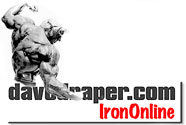The Insider's Tell-All Handbook
Weight-Training Technique
By Stuart McRobert
Book Excerpt
Trap Bar Deadlift
The trap bar, developed by Al Gerard, is a terrific aid for the deadlift and is much superior to a straight bar. It reduces spine stress relative to the straight bar deadlift, and puts the arms and hands into a near-perfect position. It also makes the lowering of the bar a reverse of the ascent. With a straight bar, lowering the weight can be a problem. This is because the knees get in the way more on the descent than they do on the ascent. The extent of this depends on the individual structure. This rhombus-like bar lets users get the best from the deadlift while keeping technique problems to a minimum. It is an outstanding bar. Urge the management of where you train to get a trap bar. All who use it will benefit.
If you are a competitive powerlifter and thus must use a straight bar at meets and in most of your training, a trap bar can still be a valuable "off" season training tool. It greatly reduces unnecessary stress but while developing strength that may have carry-over value to the straight bar deadlift (or even squat). Before a competition you would need to return to straight bar work for a cycle to "translate" any trap bar gains over to the straight bar deadlift (or squat).
With the trap bar deadlift you can involve more leg flexion if you want to make it more of a squat than a deadlift, hand spacing is determined by the gripping sites (about 22"-24" apart depending on the manufacturer), a parallel grip is used, and the bar does not drag against your thighs. The pathway of an imaginary straight line joining the ends of the bar can run "in" your body, rather than in front of it as with a straight bar. As a result of these differences, in the trap bar deadlift (done correctly) your arms will not be as near to vertical at the bottom of the exercise as they are in the deadlift with a straight bar. Your hands will be behind an imaginary vertical line dropped from your shoulders. The extent of this will be determined by your body structure and how deep you position your hips. Your arms, though, should still be straight.
Because a trap bar permits more leg flexion than does a straight bar, the trap bar deadlift can give more work to your quads than can the straight bar deadlift. The trap bar deadlift can increase thigh involvement even further if it is done from off a raised surface of an inch or two. The two critical provisos are that your lower back can be kept flat in this extended range of motion, and you have no knee limitations.
Unless you use a wide stance in the squat, use your squat stance in the trap bar deadlift. Fine-tune if you feel the need, but your squat stance should be your starting point. If you use a wide squat stance you will have to narrow it so that your legs just fit inside your arms when your hands are in position on the handles. If you cannot safely use this narrowed stance, then the trap bar deadlift is not suited to you.
With the spacing of your heels determined, you need to place your feet inside the rhombus in the best position for you. As a starting point, place your feet so that the center of the ends of the bar runs through the bony prominence in the center of the outside of each of your ankles as you stand with your legs straight. While this foot positioning will suit some people, for many people it will be a little too far forward. Try it with a very light weight and see. Then move your feet back an inch, and see how that works out. Then move another inch back, and try that. If that does not feel right, try a tad further back. Ideal foot positioning for most people will likely fall somewhere in that short range of variation.
Exactly where optimal foot positioning for you will be heavily depends on your body structure and degree of leg flexion you use. You may need several workouts of practice before you can settle on the optimum foot positioning for you. What you would look for is being able to apply a vertical pathway to the bar with no horizontal movement. If you are positioned too far to the rear, you will probably be bent forward too much and the bar may swing a little to the rear as soon as you drive it off the floor, and there will be excessive stress on your back. On the other hand, if you are positioned too far to the front, the bar will probably swing to the front as soon as you drive it off the floor.
Once you have the foot positioning that works best for you, you need a reference point so that you can consistently adopt the right setup. Use the position of the front rim of your shoes relative to the front of the rhombus. Of course your eyes need to be viewing from the same point each time. For example, as you stand upright, look down and perhaps the front rim of your shoes is directly below the inside edge of the front of the rhombus. Perhaps it is an inch inside. Get inside a trap bar and see for yourself.
If both of your hands are off center on the handles, the trap bar will tip. If just one hand is off center, dangerous rotational stress may result. You need to keep both hands perfectly centered and the rhombus parallel to the floor.
Here is a tip for how to center your hands on the handles without having to look down and lose the tensed torso and correct "get-set" position. Slice open two pieces of garden hose that are each about 1.5" long. Tape one on each handle; flush against the front bar so that when you feel your hand touching the edge of the hose you know that your hand is centered.
………
Taken from pages 69-71 of
Insider's Tell-All Handbook on Weight-Training Technique
by Stuart McRobert
Copyright 2000 Stuart McRobert
Learn more or order a Gerard Trap Bar from John Wood, a trusted friend
Return to the IronOnline bookstore
Return to the book excerpts page

